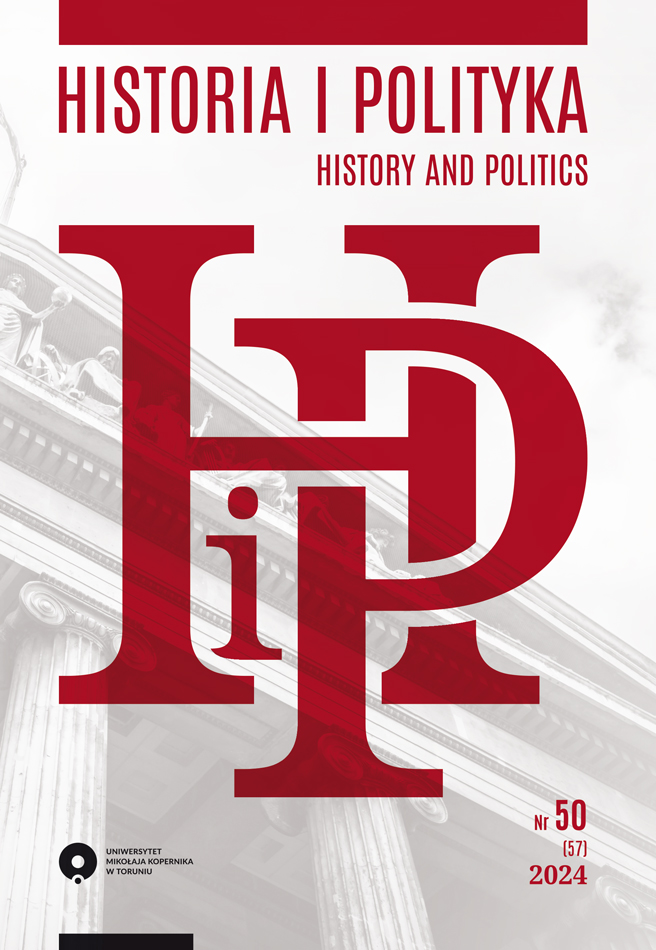Asymmetry and Imbalance in Trade between East and West in the 1980s
DOI:
https://doi.org/10.12775/HiP.2024.036Słowa kluczowe
East-West relations, trade, exports and imports, trade structure imbalance, payment asymmetry, substitute and complementary products, protectionist policy, technology transferAbstrakt
An analysis of the development of East-West trade in the 1980s and earlier allows us to draw a conclusion about the imbalance in the importance of mutual economic relations at that time. This imbalance was multi-faceted and manifested itself in, e.g., imbalance in the structure of trade in goods, payment asymmetry, as well as various motives of OECD and Comecon countries when making decisions on mutual exchange. The imbalance in the commodity structure of the East-West mutual trade reflected the fact that complementary goods were exchanged instead of, as was the case in countries characterized by a modern exchange structure, substitute products. The complementary nature of East-West trade meant that the exports of the socialist countries to the markets of the Western countries encompassed, to a large extent, different commodity groups than the imports of the Comecon countries from this area. While exports from socialist countries consisted mainly of goods with a relatively low degree of processing, the exports of capitalist countries to their Eastern partners encompassed mainly finished products with a significant degree of processing and the involvement of modern technological thought.
Bibliografia
Becker, A.S. (Ed.). (1983). Economic Relations with the USSR: Issues for the Western Alliance. Lexington, MA: Lexington Books.
Bergstrand, J.H. (1985). The Gravity Equation in International Trade: Some Microeconomic Foundations and Empirical Evidence. The Review of Economics and Statistics, 67(3), 474–481. DOI: 10.2307/1925976.
Bertsch, G.K. (1988). Controlling East-West Trade and Technology Transfer: Power, Politics, and Policies. Durham, NC–London: Duke University Press.
Bożyk, P., & Misala, J. (1988). Stosunki gospodarcze Wschód–Zachód: formy i mechanizmy. Warszawa: PWE.
Brada, J.C. (1988). Interpreting the Soviet Subsidization of Eastern Europe. International Organization, 42(4), 639–658.
Brenton, P., & Di Mauro, F. (1998). Is There Any Potential in Trade in Sensitive Industrial Products between the CEECs and the EU?. The World Economy, 21(3), 285–304. DOI: 10.1111/1467-9701.00131.
Csaba, L. (1985). Three Studies on the CMEA. Budapest: Hungarian Scientific Council for World Economy.
Csaba, L. (1988). CMEA and the Challenge of the 1980s. Soviet Studies, 40(2), 266–289. DOI: 10.1080/09668138808411753.
Drabek, Z., & Greenway, D. (1984). Economic Integration and Intra-Industry Trade: The EEC and CMEA Compared. Kyklos, 37(3), 444–469. DOI: 10.1111/j.1467-6435.1984.tb00711.x.
Economic Commission for Europe. (1988). East-West Joint Ventures: Economic, Business, Financial and Legal Aspects. New York: United Nations.
Eurostat. (1985). Basic Statistics of the Community.
Gospodarka światowa i gospodarka Polska w 1985 r. (1986). Warszawa: SGPiS.
Gospodarka światowa i gospodarka Polska w 1986 r. (1987). Warszawa : SGPiS.
Gospodarka światowa i gospodarka polska w 1987 r. (1988). Warszawa: SGPiS.
Gospodarka światowa i gospodarka polska w 1988 r. (1989). Warszawa: SGPiS.
Góralski, W. (1990). Stosunki Japonii z krajami Europy Środkowo-Wschodniej. Sprawy Międzynarodowe, 43(9), 32–47.
Grabska, W. (1989). Uwarunkowania rozwoju stosunków gospodarczych Wschód–Zachód w latach osiemdziesiątych. Warszawa: PISM.
Hamilton, C.B., & Winters, L.A. (1992). Opening Up International Trade with Eastern Europe. Economic Policy, 7(14), 77–116. DOI: 10.2307/1344513.
Holzman, F.D. (1985). Comecon: A “Trade-Destroying” Customs Union?. Journal of Comparative Economics, 9(4), 410–423. DOI: 10.1016/0147-5967(85)90020-4.
Ickes, B.W. (1990). Do Socialist Countries Suffer a Common Business Cycle?. The Review of Economics and Statistics, 72(3), 397–405. DOI: 10.2307/2109347.
Lavigne, M. (1990). Economic Relations between Eastern Europe and the USSR: Bilateral Ties v. Multilateral Cooperation. Paris: Institut de Science Economique et Mathematiques Appliquees.
Messerlin, P.A. (1989). The EC Antidumping Regulations: A First Economic Appraisal, 1980–85. Review of World Economics, 125(3), 563–587. DOI: 10.1007/BF02707668.
Nello, S.S. (1990). Some Recent Developments in EC–East European Economic Relations. Journal of World Trade, 24(1), 5–24. DOI: 10.54648/trad1990001.
Oblath, G., & Pete, P. (1985). Trade with the Soviet Union: the Finnish Case. Acta Oeconomica, 35(1–2), 165–194.
Rosati, D. (1990, October). Impact of Replacing CMEA Trade Regime by a Market Trade Regime: Poland. Warsaw: Foreign Trade Research Institute.
RWPG–EWG: współpraca i współzawodnictwo. (1990). Biuletyn Ekonomiczny, 1698, 45–58.
Smith, A. (1987). Strategic Investment, Multinational Corporations and Trade Policy. European Economic Review, 31 (1–2), 89–96. DOI: 10.1016/0014-2921(87)90018-3.
Smolik, J.E. (1988). Evolution of External Trade and Payments of the European Centrally Planned Economies. Paris: OECD.
Stankovsky, J. (1973). Determinant Factors of East-West Trade. Soviet and Eastern European Foreign Trade, 9(2), 3−40.
Steiner, A. (2014). The Globalisation Process and the Eastern Bloc Countries in the 1970s and 1980s. European Review of History, 21(2), 165–181. DOI: 10.1080/13507486.2014.888704.
Steinherr, A. (1992). The Evolution of East-West Trade and the Role of the ECU in Eastern Europe. MOST: Economic Policy in Transitional Economies, 2(3), 3–15. DOI: 10.1007/BF01101436.
Vanous, J. (1990, June 8). Soviet Energy Developments in 1989. Plan Econ Report.
Wienert, H., & Slater, J. (1986). East-West Technology Transfer: The Trade and Economic Aspects. Paris: OECD.
Wpływ zmian na Wschodzie na wzrost gospodarczy Europy Zachodniej. (1990). Biuletyn Ekonomiczny, 1696, 23–35.
Zachodnia polityka ograniczania eksportu do krajów socjalistycznych. (1987). Biuletyn Ekonomiczny, 1522, 15–27.
Pobrania
Opublikowane
Jak cytować
Numer
Dział
Licencja
Prawa autorskie (c) 2024 Zbigniew Klimiuk

Utwór dostępny jest na licencji Creative Commons Uznanie autorstwa – Bez utworów zależnych 4.0 Międzynarodowe.
Uniwersytet Mikołaja Kopernika w Toruniu respektuje prawo do prywatności i ochrony danych osobowych autorów.
Dane autorów nie są wykorzystywane w celach handlowych i marketingowych. Redaktorzy i recenzenci są zobowiązani do zachowania w poufności wszelkich informacji związanych ze złożonymi do redakcji tekstami.
Autor, zgłaszając swój tekst wyraża zgodę na wszystkie warunki i zapisy umowy licencyjnej (określającej prawa autorskie) z Uniwersytetem Mikołaja Kopernika w Toruniu.
Statystyki
Liczba wyświetleń i pobrań: 196
Liczba cytowań: 0



